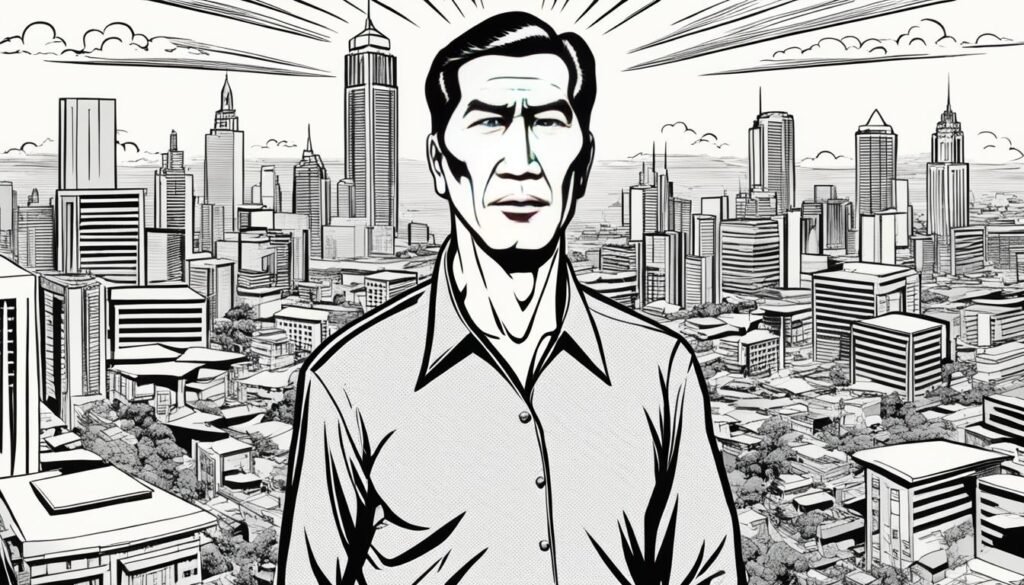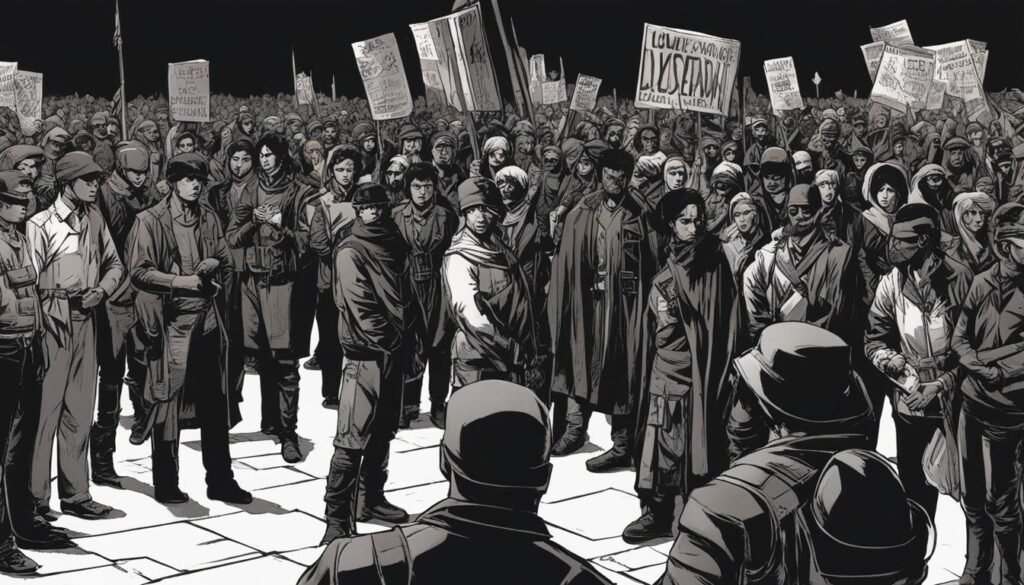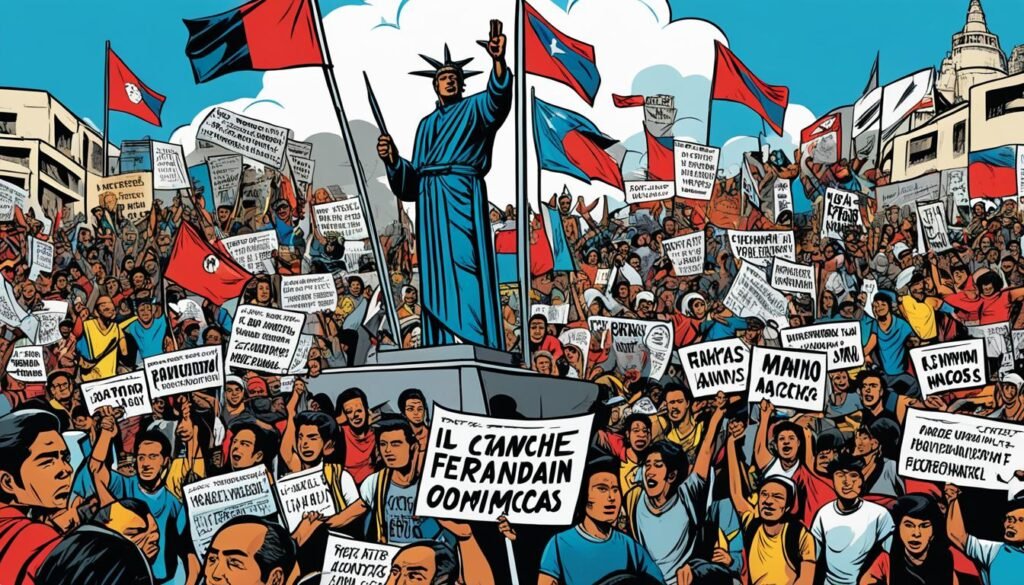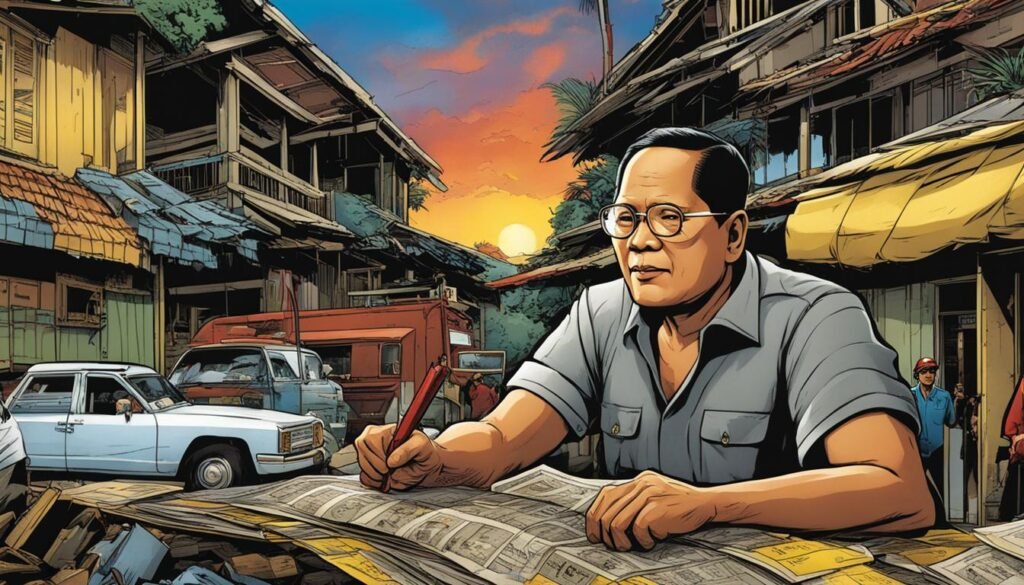In this article, we will delve into the pivotal events that defined the Ferdinand Marcos era, from his declaration of Martial Law to his eventual ouster through the People Power Revolution. This period in Philippine history shaped the nation and its people, leaving a lasting impact that is still felt today.
Ferdinand Marcos, a controversial figure, served as the President of the Philippines from 1965 until his ouster in 1986. During his regime, he declared Martial Law, which lasted from 1972 to 1981, exerting authoritarian control over the country. This period was marked by human rights abuses, censorship, and widespread corruption.
The declaration of Martial Law was justified by Marcos as a means to restore law and order and combat internal threats and communist insurgencies. However, it resulted in the suppression of civil liberties, arbitrary arrests, torture, and extrajudicial killings. The Filipino people lived in fear under a regime that silenced opposition and stifled dissent.
Key Takeaways:
- Ferdinand Marcos ruled as President of the Philippines from 1965 to 1986.
- His declaration of Martial Law in 1972 led to a period of authoritarian rule.
- Martial Law was characterized by human rights abuses, censorship, and corruption.
- The People Power Revolution in 1986 marked the end of Marcos’ regime.
- The effects of the Marcos era continue to shape the Philippines today.
Early Life and Military Career
Ferdinand Marcos, born on September 11, 1917, in Sarrat, Ilocos Norte, Philippines, had a formative early life that would greatly influence his future political ambitions. With a strong academic foundation and a family background in public service, Marcos displayed early signs of leadership and determination.
Attending school in Manila, Marcos excelled in academics, where he earned multiple scholarships, including the prestigious Barbour Scholarship, which allowed him to pursue further studies in law and political science at the University of Michigan.
World War II played a significant role in shaping Marcos’ military career. As a law student, he joined the ROTC, and when war broke out, he enlisted in the Armed Forces of the Philippines, eventually becoming a guerrilla leader. Marcos’ military service during the war contributed to his image as a strong and decisive leader.
Following World War II, Marcos launched into a political career, serving first as a member of the Philippine House of Representatives and later as a senator. His military background and reputation garnered support among the people and helped pave the way for his rise to the presidency.
Milestones in Ferdinand Marcos’ Early Life and Military Career:
- Educational Achievements:
- Multiple scholarships
- Pursued law and political science at the University of Michigan
- World War II Service:
- Joined ROTC and enlisted in the Armed Forces of the Philippines
- Became a guerrilla leader
- Political Aspirations:
- Served as a member of the Philippine House of Representatives
- Later became a senator
Through his early life and military career, Ferdinand Marcos laid the foundation for his rise to power. From his academic achievements and wartime leadership to his entry into politics, these experiences shaped his persona and set the stage for his presidency and the tumultuous era that would follow.
Marcos’ Presidency and Consolidation of Power
After securing his election as the 10th President of the Philippines in 1965, Ferdinand Marcos began his term with a vision of implementing policies that would bring rapid progress and economic stability to the nation. However, as his presidency progressed, Marcos increasingly focused on consolidating power and quelling opposition, ultimately leading to the declaration of Martial Law in 1972.
Stonehill Scandal and Political Turmoil
One significant event that played a role in Marcos’ consolidation of power was the Stonehill scandal. The scandal involved allegations of corruption and tax evasion by influential individuals close to Marcos and his administration. The ensuing political turmoil provided Marcos with an opportunity to strengthen his grip on power by targeting his political adversaries and consolidating control over key government institutions.
“The preservation of Marcos’ presidency became paramount, and he leveraged the Stonehill scandal and subsequent political chaos to enact measures that would ensure his dominance.” – Political Analyst
During this period, Marcos also exploited his cult of personality to bolster his position. He cultivated an image of himself as a strong and charismatic leader, using media propaganda to shape public perception and maintain popular support. Through his charm and strategic messaging, Marcos built a loyal following that further solidified his control.
The Cult of Marcos and the Manipulation of Democracy
As part of his consolidation of power, Marcos took advantage of weak democratic institutions and manipulated the political system to his advantage. He amended the constitution to remove term limits, effectively allowing himself to remain in power indefinitely. With the deck stacked in his favor, Marcos curtailed press freedom, silenced critics, and marginalized opposition groups.
This consolidation of power culminated in Marcos’ fateful decision to declare Martial Law on September 21, 1972. Citing threats to national security and the need for stability, Marcos effectively suspended democratic processes and installed an authoritarian regime, centralizing power in the hands of the presidency.
Consolidation of Power Table:
| Key Elements of Marcos’ Consolidation of Power | Impact on the Presidency |
|---|---|
| Exploitation of the Stonehill scandal and political turmoil | Strengthened Marcos’ control and weakened opposition |
| Cultivation of a cult of personality | Built a loyal following and maintained popular support |
| Manipulation of democratic institutions | Amendment of the constitution to remove term limits and curtailment of press freedom |
| Declaration of Martial Law | Consolidation of authoritarian rule and suspension of democratic processes |
Through the consolidation of power, Marcos transformed the presidency into an instrument of control rather than a vehicle for democratic governance. The ramifications of these actions would be felt throughout the nation, ultimately leading to a period of repression, human rights abuses, and a climate of fear.

In the next section, we will explore the declaration of Martial Law by Ferdinand Marcos, and the human rights abuses that ensued under his oppressive regime.
Martial Law Declaration and Human Rights Abuses
One of the most significant events during Ferdinand Marcos’ regime was his declaration of Martial Law in the Philippines. On September 21, 1972, Marcos, then serving as the President, imposed Martial Law under Proclamation No. 1081. He justified this drastic measure by citing various reasons such as the need to preserve national security, protect the economy, and combat the rising threat of communism.
However, the declaration of Martial Law had far-reaching consequences, particularly in terms of human rights abuses. The Marcos regime implemented a repressive apparatus that disregarded fundamental civil liberties, leading to widespread violations and atrocities. Numerous reports and testimonies documented cases of torture, extrajudicial killings, disappearances, and arbitrary arrests.
The enforcement of Martial Law gave Marcos unrestrained power and authority over the country, allowing him to suppress political opposition and consolidate his control. Civil society organizations, student activists, and other dissenting voices were systematically targeted and silenced.
“The Filipino is worth dying for.” – Benigno Aquino Jr.
During this dark period of Martial Law, many brave individuals stood up against the tyranny and fought for justice and freedom. One notable figure was Senator Benigno ‘Ninoy’ Aquino Jr. His courageous opposition to the Marcos regime eventually cost him his life. On August 21, 1983, Aquino was assassinated upon his return to the Philippines from exile. His death sparked outrage and fueled the growing resistance against Marcos.
The human rights abuses committed under Martial Law remain a painful chapter in Philippine history. The scars left by this period continue to impact individuals and communities today. The pursuit of truth, justice, and accountability for the victims has been an ongoing struggle for the Filipino people.
Marcos’ declaration of Martial Law and the subsequent human rights abuses had a profound and lasting impact on the Philippines. It is crucial to remember and learn from this dark period to ensure that such violations are never repeated.
| Impact of Martial Law | Examples |
|---|---|
| Suppressing political opposition | Arbitrary arrests and detentions of activists and dissenters |
| Violence and coercion | Torture, extrajudicial killings, and enforced disappearances |
| Suppression of media and free speech | Censorship, closure of independent media outlets |
| Impact on indigenous communities | Forced displacement, land grabbing |
Opposition and Resistance
Despite the oppressive regime under Ferdinand Marcos, various forms of opposition and resistance movements emerged, fueled by the relentless spirit of the Filipino people. These movements played a crucial role in challenging Marcos’ authority and advocating for a more democratic Philippines.
Religious Groups:
Religious groups, such as the Catholic Church, played a significant role in opposing Marcos’ regime. Religious leaders, including Archbishop Jaime Cardinal Sin, condemned the human rights abuses and called upon their followers to stand up for justice and freedom.
Indigenous Communities:
Indigenous communities across the Philippines also voiced their opposition to Marcos’ dictatorship. These communities, deeply rooted in their ancestral lands and traditions, resisted the encroachments of the regime on their territories. Their resilience and determination served as an inspiration to the broader opposition movement.
Workers’ Organizations:
Workers’ organizations, including labor unions and activist groups, mobilized against Marcos’ oppressive labor policies and fought for workers’ rights. They organized strikes and protests, demanding better working conditions and fair treatment in the face of exploitation.
“The resistance against Ferdinand Marcos was a collective effort – a testament to the unwavering spirit of the Filipino people, united in their pursuit of freedom and justice.”
In addition to these organized forms of opposition, protest art and music emerged as powerful tools in mobilizing the resistance. Artists and musicians expressed their dissent through their creations, using their platforms to convey messages of defiance and hope. These artistic expressions resonated with the masses, providing a rallying point for the opposition movement.

Despite the risks and the constant threat of retaliation, the opposition and resistance movements stood strong, determined to bring about change and restore democracy to the Philippines. The collective efforts of these brave individuals and communities laid the foundation for the eventual downfall of Ferdinand Marcos and the restoration of freedom for the Filipino people.
Economic Policies and Controversies
During Ferdinand Marcos’ presidency, his economic policies sparked controversies and had a significant impact on the Philippines. Some of his key policies, such as monopolies, cronyism, and the Coco Levy Fund scam, led to widespread criticism and allegations of corruption.
“The concentration of economic power in the hands of a few favored individuals and corporations created an environment of inequality and unfair competition.”
One of Marcos’ controversial projects was the Chico River Dam, which faced opposition from indigenous communities and environmental activists due to its potential impact on the environment and displacement of local residents.
Table: Controversial Economic Policies and Projects during Marcos’ Presidency
| Policy/Project | Description |
|---|---|
| Monopolies | Marcos’ regime allowed certain cronies to establish monopolies in industries such as telecommunications, media, and mining, stifling competition and favoring specific individuals. |
| Coco Levy Fund scam | Marcos imposed a levy on coconut farmers, allegedly to develop the coconut industry. However, the funds were mismanaged and embezzled, leading to prolonged legal battles and unresolved issues. |
| Bataan Nuclear Power Plant | Marcos’ decision to build the Bataan Nuclear Power Plant raised concerns about safety, corruption, and the financial burden it would place on the country. The plant remains unused to this day. |
These economic policies and projects, accompanied by the allegations of corruption, further fueled public discontent and opposition towards Marcos’ regime.
People Power Revolution and Marcos’ Ouster
The People Power Revolution of 1986 was a momentous event in Philippine history that marked a turning point in Ferdinand Marcos’ rule. The revolution, also known as the EDSA Revolution, was a peaceful mass movement that eventually led to Marcos’ ouster and the restoration of democracy in the country.
The revolution was preceded by the assassination of Benigno Aquino Jr., a prominent opposition leader, in 1983. Aquino’s death sparked widespread public outrage and further fueled the growing opposition against Marcos’ regime. The 1986 election, which was marred by allegations of fraud and corruption, galvanized the opposition and set the stage for the revolution.
“The Filipino is worth dying for.”
– Benigno Aquino Jr.
Mass protests, led by a diverse coalition of religious groups, students, civil society organizations, and political figures, played a pivotal role in the People Power Revolution. These protests, held primarily along Epifanio de los Santos Avenue (EDSA) in Manila, drew millions of people demanding democratic reforms and the end of Marcos’ oppressive rule.
The international community also played a significant role in pressuring Marcos to step down. The United States, a longtime ally of the Philippines, withdrew its support for Marcos and backed Corazon Aquino, the widow of Benigno Aquino Jr., as a legitimate alternative to his regime. The presence of international media coverage further exposed the human rights abuses and corruption under Marcos’ rule, adding to the global condemnation and pressure for change.

The culmination of the People Power Revolution came on February 25, 1986, when Marcos fled Malacañang Palace and went into exile. Corazon Aquino, known as “Cory,” was sworn in as the new President of the Philippines, ushering in a new era of democracy and hope for the Filipino people.
The People Power Revolution remains a powerful symbol of the Filipino people’s resilience and their unwavering commitment to democracy. It serves as a reminder that even in the face of oppression, the collective strength and unity of the people can bring about significant change.
Marcos’ Legacy and Historical Distortion
As the Ferdinand Marcos era came to an end with the People Power Revolution, the debate surrounding his legacy continues to shape public discourse in the Philippines. It is essential to critically examine the historical distortion that some argue has occurred, particularly regarding Marcos’ accomplishments and the extent of the human rights abuses during his regime.
“The great tragedy of our time has been the hijacking of public memory by myths and pretenders who, through successful distortion tactics, have tried to negate the historical record and real significance of the events associated with the Marcos dictatorship.”
– Marites Vitug, Philippine journalist and author
One aspect of Marcos’ legacy that has been subject to historical distortion is his alleged accomplishments. Supporters of Marcos argue that his authoritarian rule brought about economic progress and infrastructure development. However, it is essential to recognize that the economic growth during his regime was highly uneven, concentrating wealth and power among a select few, including the Marcos family and their cronies.
The Marcos regime also faced allegations of corruption, embezzlement, and nepotism. The Marcos family accumulated vast amounts of unexplained wealth, leading to ongoing investigations and legal battles. These controversies have further contributed to the historical distortion, as they highlight the extent of corruption and abuse of power during the Marcos era.
Another area of historical distortion relates to the human rights abuses committed under Marcos’ regime. While some argue that these abuses have been exaggerated, the evidence and testimonies from survivors paint a grim picture of widespread torture, disappearances, and extrajudicial killings. Human rights organizations and documented cases provide irrefutable proof of the violations that occurred during this period.
To gain a holistic understanding of Marcos’ legacy, it is crucial to acknowledge both his alleged accomplishments and the grave human rights abuses that occurred under his rule. By critically examining the historical record and engaging in open discussions, we can promote a more accurate understanding of this significant period in Philippine history.
| Key Points | Implications |
|---|---|
| Marcos’ alleged accomplishments | Economic disparities and concentrated wealth among the Marcos family and cronies |
| Corruption and embezzlement | Unexplained wealth of the Marcos family and ongoing investigations |
| Human rights abuses | Evidence of widespread torture, disappearances, and extrajudicial killings |
The Marcos Family and Unexplained Wealth
The Marcos family played a significant role in Ferdinand Marcos’ regime and the years that followed. Their influence extended beyond politics, encompassing business ventures and controversies surrounding their unexplained wealth.
One aspect that raises questions is the Marcos family’s overseas landholdings. They were known to own various properties abroad, including prime real estate in New York City. These acquisitions generated speculation about the source of their wealth and the methods used to acquire such valuable assets.
The Marcos family’s wealth was not limited to overseas investments. They also possessed luxurious mansions within the Philippines, which further fueled public curiosity about the origins of their riches. These opulent residences, often surrounded by controversy and associated with the excessive display of wealth, became emblematic of the Marcos family’s privileges during Ferdinand Marcos’ regime.
One theory that has gained attention is the Tallano gold conspiracy theory. According to this theory, the Marcos family allegedly gained their vast fortune from a hidden cache of gold left by a royal Filipino clan during Spanish colonization. While widely dismissed as an unsubstantiated claim, it nonetheless exemplifies the intrigue and speculation surrounding the Marcos family’s unexplained wealth.
The controversies surrounding the Marcos family’s unexplained wealth continue to ignite public interest and debate. As the Philippines strives to uncover the truth behind their riches, the legacy of Ferdinand Marcos and the enduring impact of his regime remain subject to ongoing scrutiny.

Notable Points:
- The Marcos family’s overseas landholdings have sparked speculation about the source of their wealth.
- Luxurious mansions owned by the Marcos family within the Philippines raised questions about the origins of their riches.
- The Tallano gold conspiracy theory suggests an alternative explanation for the Marcos family’s vast fortune.
- The controversies surrounding the Marcos family’s unexplained wealth continue to fuel public interest and debate.
Challenges and Achievements of the Aquino Administration
After the ouster of Ferdinand Marcos, Corazon Aquino assumed the presidency, bringing hope for a new era in the Philippines. However, the Aquino administration faced significant challenges during its term, ranging from economic difficulties to internal dissension and natural disasters. Despite these obstacles, the administration also achieved notable reforms and accomplishments that shaped the country’s future.
Challenges
- Economic Difficulties: The Aquino administration inherited an economy in turmoil. The country faced high inflation, a large external debt, and a struggling agricultural sector. Aquino had to implement reforms to stabilize the economy and attract foreign investments.
- Internal Dissension: The Philippines experienced political turbulence during Aquino’s presidency, with coup attempts and challenges to her authority. Facilitating unity and maintaining stability required strong leadership and strategic decision-making.
- Natural Disasters: The Philippines is prone to natural disasters such as typhoons and earthquakes. Aquino’s administration had to respond swiftly to mitigate the impact of such events, provide aid to affected communities, and rebuild damaged infrastructure.
Achievements and Reforms
Despite the challenges, the Aquino administration made significant achievements and implemented key reforms that laid the foundation for a more democratic and progressive Philippines.
- Restoration of Democracy: Aquino’s presidency marked the return of democracy in the Philippines, ending the era of authoritarian rule under Marcos. She restored civil liberties, freedom of speech, and the rule of law.
- Land Reform: Aquino initiated and implemented the Comprehensive Agrarian Reform Program (CARP), aiming to redistribute agricultural lands to farmers and promote social justice. This reform sought to address historical land inequalities and empower rural communities.
- Constitutional Reform: The Aquino administration successfully drafted and ratified a new constitution in 1987. This constitution introduced safeguards against abuse of power, strengthened democratic institutions, and enshrined human rights.
“Our democracy will be more participatory; our government will be more accountable and transparent; and our economy will be more equitable, that each Filipino will have food, shelter, and the opportunity for a dignified life.” – Corazon Aquino
The Aquino administration’s dedication to democratic principles and commitment to social justice left a lasting impact on the Philippines. Despite the challenges faced, Aquino’s reforms paved the way for a more inclusive society and set the stage for future progress.

Conclusion
In conclusion, the Ferdinand Marcos era was a tumultuous period in Philippine history. Marcos’ declaration of Martial Law in 1972 marked the beginning of a dark chapter characterized by human rights abuses and the suppression of dissent. However, the Filipino people’s resilience and their relentless pursuit of freedom culminated in the historic People Power Revolution of 1986.
The People Power Revolution, also known as the EDSA Revolution, showcased the power of peaceful mass mobilization and unity against an oppressive regime. It was a turning point that led to the ouster of Ferdinand Marcos and the restoration of democracy in the Philippines. The significance of the revolution reverberates to this day, serving as a symbol of hope and a reminder of the enduring spirit of the Filipino people.
The legacy of Ferdinand Marcos and the events of this era continue to shape the Philippines today. It is a reminder of the importance of safeguarding democracy, protecting human rights, and upholding the values of justice and accountability. The scars of the past remain, but they serve as a reminder of the resilience and determination of the Filipino people to build a better future.
FAQ
What is the significance of the Ferdinand Marcos era?
The Ferdinand Marcos era is significant because it encompasses his declaration of Martial Law, human rights abuses, and the eventual ouster through the People Power Revolution.
How did Ferdinand Marcos rise to power?
Ferdinand Marcos rose to power through his early life and military career, which included his education, World War II service, and political aspirations.
What were some key events during Marcos’ presidency?
Some key events during Marcos’ presidency include his election, implementation of policies, and the consolidation of power that eventually led to the declaration of Martial Law.
Why did Ferdinand Marcos declare Martial Law?
Ferdinand Marcos cited various reasons for declaring Martial Law, including the need for national security and the suppression of dissent.
What were the human rights abuses during Ferdinand Marcos’ regime?
Human rights abuses during Ferdinand Marcos’ regime included cases of torture, extrajudicial killings, and disappearances.
How did opposition movements emerge during Marcos’ regime?
Opposition movements emerged during Marcos’ regime from various sectors, including religious groups, indigenous communities, and workers’ organizations.
What were some controversies surrounding Marcos’ economic policies?
Controversies surrounding Marcos’ economic policies included monopolies, cronyism, and the Coco Levy Fund scam. Additionally, projects such as the Chico River Dam and the Bataan Nuclear Power Plant were sources of controversy.
What led to Ferdinand Marcos’ ouster?
Ferdinand Marcos’ ouster was primarily the result of the People Power Revolution, which was fueled by mass protests, the international pressure, and the growing opposition to his regime.
What is the ongoing debate surrounding Ferdinand Marcos’ rule?
The ongoing debate surrounding Ferdinand Marcos’ rule includes discussions about the extent of historical distortion, particularly regarding his accomplishments and the human rights abuses during his regime.
What was the role of the Marcos family in Ferdinand Marcos’ regime?
The Marcos family played a significant role in Ferdinand Marcos’ regime and aftermath, with involvement in business, politics, and controversies surrounding their unexplained wealth.
What were the challenges faced by the Aquino administration?
The Aquino administration faced challenges such as economic difficulties, internal dissension, and natural disasters. However, they also implemented achievements and reforms during their term.
How did the Ferdinand Marcos era shape the Philippines?
The Ferdinand Marcos era, with its declaration of Martial Law, human rights abuses, and the People Power Revolution, continues to shape the Philippines to this day.


